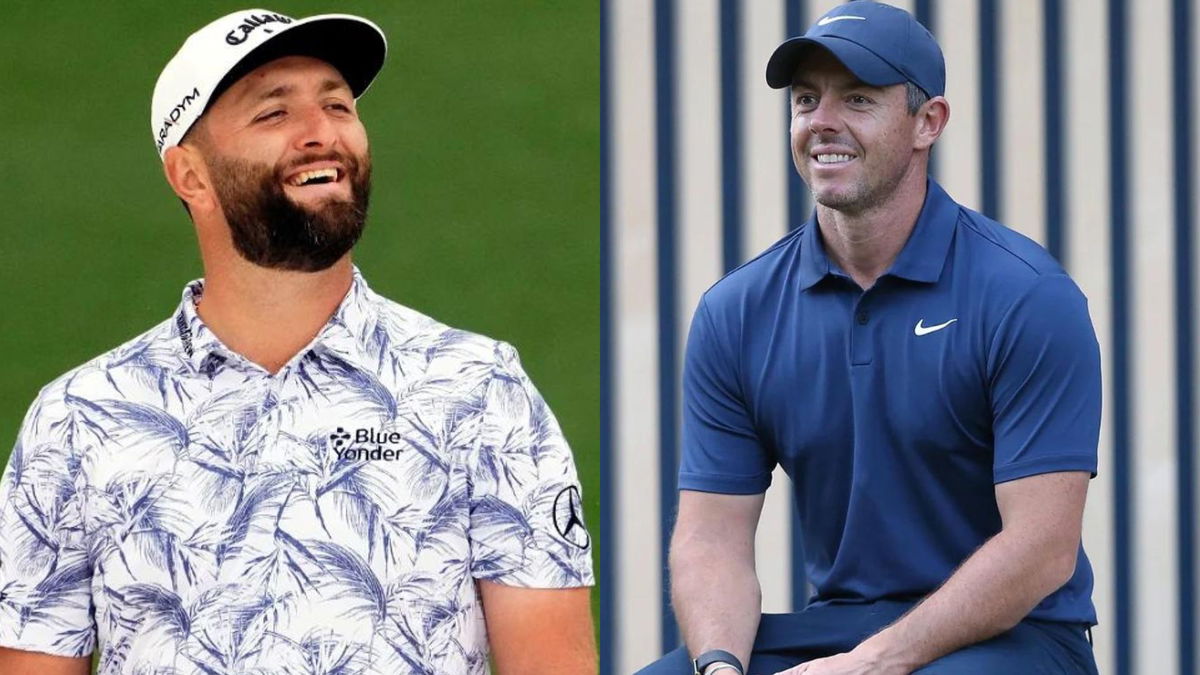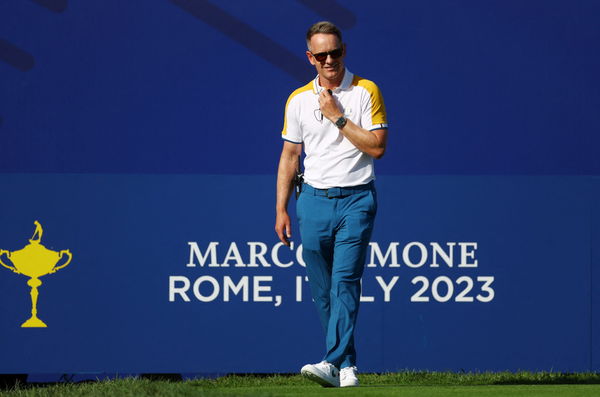
Imago
Source Credit: IMAGO

Imago
Source Credit: IMAGO
The Ryder Cup is never just about drives and putts; it’s a test of chemistry under pressure. As the 2025 edition approaches Bethpage Black, the spotlight has turned to how the two sides build that elusive team unity. Reports of tension between Jon Rahm and Rory McIlroy after Rahm’s LIV Golf move provided a reminder that even the most decorated squads can feel internal strain. So what is Luke Donald to do when some questions arise naturally? U.S.A. Today’s Golfweek asked the European captain: “What are the key ingredients for creating unity in Team Europe?”
Watch What’s Trending Now!
Luke Donald addressed the issue head-on, saying, “It’s about creating the right culture. That’s something I worked hard on going into Rome, and I have done again so far in the lead up to Bethpage. Communication is an important part of that. I try to have regular communication with the players and keep that bond strong throughout the two years.”
Donald’s approach is deliberate and long-term. He has kept close contact with the players since Europe’s win in Rome, ensuring that differences never fester into distractions. The numbers reflect that philosophy: 11 of the 12 players who hoisted the trophy in 2023 return for Bethpage, the highest carryover Europe has fielded in decades. That continuity allows shared rituals, team trips, practice sessions, and informal fireside talks to deepen trust. Europe’s history reinforces this culture: the side has captured 10 of the last 14 Ryder Cups, repeatedly crediting unity as the deciding edge.
ADVERTISEMENT
About that stellar unity, Donald further added, “Unity is something we’ve become renowned for as Team Europe and as captain, you try to stay true to that but also build on it and move it forward with each Ryder Cup.” Team USA follows a different blueprint. Rather than slow-burning cohesion, Captain Keegan Bradley has focused on concentrated bonding and visible chemistry. He called his squad “the closest team I’ve ever seen,” a statement backed by action. Ten of the twelve U.S. players competed together at the Procore Championship tune-up from Sept 11 to September 14, 2025, using the event to sharpen the pairings and reinforce camaraderie in real competition.

Reuters
Golf – The 2023 Ryder Cup – Marco Simone Golf & Country Club, Rome, Italy – September 26, 2023 Team Europe captain Luke Donald ahead of the 2023 Ryder Cup REUTERS/Carl Recine
Bradley’s decision to leave himself off the roster was another unifying signal, prioritizing team balance over personal ambition. The contrast between the two captains’ methods is striking. Europe invests in continuous, private communication over two years, while the U.S. leans on high-intensity gatherings just before the Cup. Each tactic carries risk: Europe must ensure that old tensions, such as the Rahm–McIlroy dynamic, don’t harden over time, while the Americans gamble that short-term chemistry will hold under the crucible of match play. Both teams, however, understand that leadership style matters as much as talent.
ADVERTISEMENT
Donald projects calm authority, described by players as “quiet confidence,” whereas Bradley is energetic and outspoken, rallying his group in public. Experience is another dividing line. Europe’s veterans, McIlroy with a 16–13–4 Ryder Cup record and Rahm with 7.5 career points, anchor a lineup already steeped in match-play tactics. The United States balances stalwarts like Scottie Scheffler and Patrick Cantlay with fresh faces eager to erase the memory of their 2023 defeat. Blending veterans and rookies can spark energy, but Europe’s proven pairings and institutional memory remain a formidable weapon when pressure peaks late on Sunday.
When the first tee roars at Bethpage on September 26, unity will be tested in real time. Europe brings the advantage of deep bonds and a decade-spanning culture; the United States counters with high morale and intense recent togetherness. Whether Donald’s slow-build strategy or Bradley’s quick-bond approach proves stronger, the winner will be the team whose relationships stay tightest when the pressure and the noise reach their peak.
ADVERTISEMENT
Yet even as Luke Donald doubled down on Europe’s trademark unity, whispers of an undercurrent between his two biggest stars, Rory McIlroy and Jon Rahm, hinted that harmony might not be as effortless as it looked.
Jon Rahm-Rory McIlroy Rift Exposed by NBC Commentator
In the fading Roman sunlight at Marco Simone, Rory McIlroy stood on the 18th green with tears in his eyes. Europe had just reclaimed the Ryder Cup in 2023, and his emotional speech about the victory became the defining image of the evening. McIlroy’s fist-pumping heroics and crowd-rallying energy made him the heartbeat of Team Europe.
Yet just a few feet away, Jon Rahm sat quietly, his own pivotal contributions, such as halving his singles match against world No. 1 Scottie Scheffler, barely acknowledged. That subdued scene, now recounted by NBC analyst Brandel Chamblee on The Favorite Chamblee podcast, may have marked the first visible crack in their dynamic.

Imago
PGA, Golf Herren The Open Championship – First Round July 20, 2023 Hoylake, England, GBR Rory McIlroy left and Jon Rahm look on during the first round of The Open Championship golf tournament at Royal Liverpool. Hoylake Royal Liverpool ENGLAND GBR, EDITORIAL USE ONLY PUBLICATIONxINxGERxSUIxAUTxONLY Copyright: xKylexTeradax 20230720_ojr_st3_339
Chamblee painted the media center moment in striking detail. He recalled Rahm looking “pretty disgruntled,” waiting as most questions went to McIlroy. When Rahm was finally addressed, “he acted like he was asleep,” Chamblee said, adding that the Spaniard appeared annoyed at the lack of attention. McIlroy, noticing the tension, tried to defuse it with a light remark: “he’s only the number one player in the world,” even though Rahm wasn’t officially No. 1 at the time. It was a telling exchange: the team’s second-biggest star momentarily eclipsed, despite having just posted a stellar 2-0-2 record for three points and arriving as the reigning Masters champion.
Meanwhile, McIlroy’s profile off the course was surging. He finished the season as Europe’s top scorer with a 4–1–0 record and four points and topped the PGA Tour’s 2023 Player Impact Program, earning a $15 million bonus for his unmatched influence across media and fan engagement. His outspoken stance against LIV Golf, widely celebrated among traditional golf fans, only amplified the spotlight on him. Against that backdrop, Rahm’s quieter demeanor and eventual decision to join LIV late in 2023 now seem less surprising.
Chamblee’s insight reframes what once looked like harmless body language as an early signal of deeper feelings; perhaps frustration over recognition, perhaps a sense of being overshadowed. Within months of that Ryder Cup, Rahm’s defection to LIV Golf shocked the sport, lending weight to the notion that the imbalance he felt in Rome lingered. Whether it was about media attention, influence in the game, or broader career choices, the Bethpage-bound Team Europe must now manage a partnership whose chemistry is more complex than the smiles on the trophy stand once suggested.
ADVERTISEMENT
ADVERTISEMENT
ADVERTISEMENT
ADVERTISEMENT

